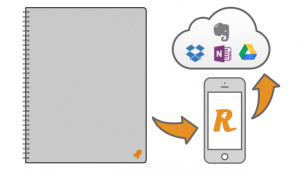Microwave Your Notebook, Please
-
-
slice.mit.edu
Filed Under
Recommended
“In a variety of roles, I struggled with the reality that I always wanted and needed my notes digitized and stored. But no matter how hard I tried, there was never anything like pen and paper,” Lemay says.

This challenge to easily digitize handwritten notes inspired Lemay to create Rocketbook, an app and notebook system that lets users upload handwritten notes and sketches to cloud services with no transcribing required.
The Rocketbook app works in conjunction with the Rocketbook notebook, which looks a lot like a regular notebook. The notebook allows you to jot down your notes and then color in a box at the bottom of each page that corresponds to the cloud service of your choice. The mobile app then turns your notes and drawings into high-quality images and loads them directly to the cloud.
Although individual Rocketbook note pages can be printed from the Rocketbook website, users may want to spring for the full Rocketbook notebook. Why? Pop it in the microwave and find out. Rocketbook notebooks are designed to be reused. With the help of an erasable pen, the notebooks can be microwaved and used again.

“Essentially the eraser from these pens creates heat from the friction. The pen ink turns clear when it reaches the high temperature created by that friction,” he explains. Lemay discovered that the level of heat needed to turn the pen ink clear can be achieved in the microwave. So when you fill up your Rocketbook notebook, pop it in the microwave and start over new.
Despite the inherent fun of Rocketbook, Lemay wasn’t sure if customers would be interested in the product and unsure whether to pursue funding from investors. “We let the market dictate whether we should pursue this idea,” he says. Lemay let the market decide by sharing the idea for Rocketbook in an Indiegogo fundraising campaign. The market responded by funding Rocketbook 3,563 percent of the original $20,000 fundraising goal.
Lemay credits part of his success to the help of the Venture Mentoring Service (VMS), which Lemay has worked with since the early days of Rocketbook. Lemay says he has many ideas for the future of Rocketbook, but right now he’s working on getting the hundreds of preordered Rocketbooks in the mail to awaiting customers.







